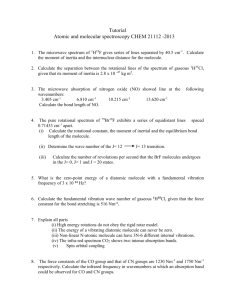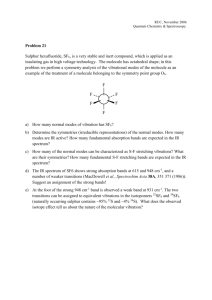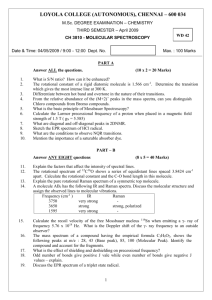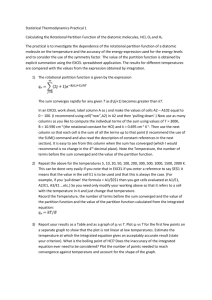FLORIDA INTERNATIONAL UNIVERSITY
advertisement
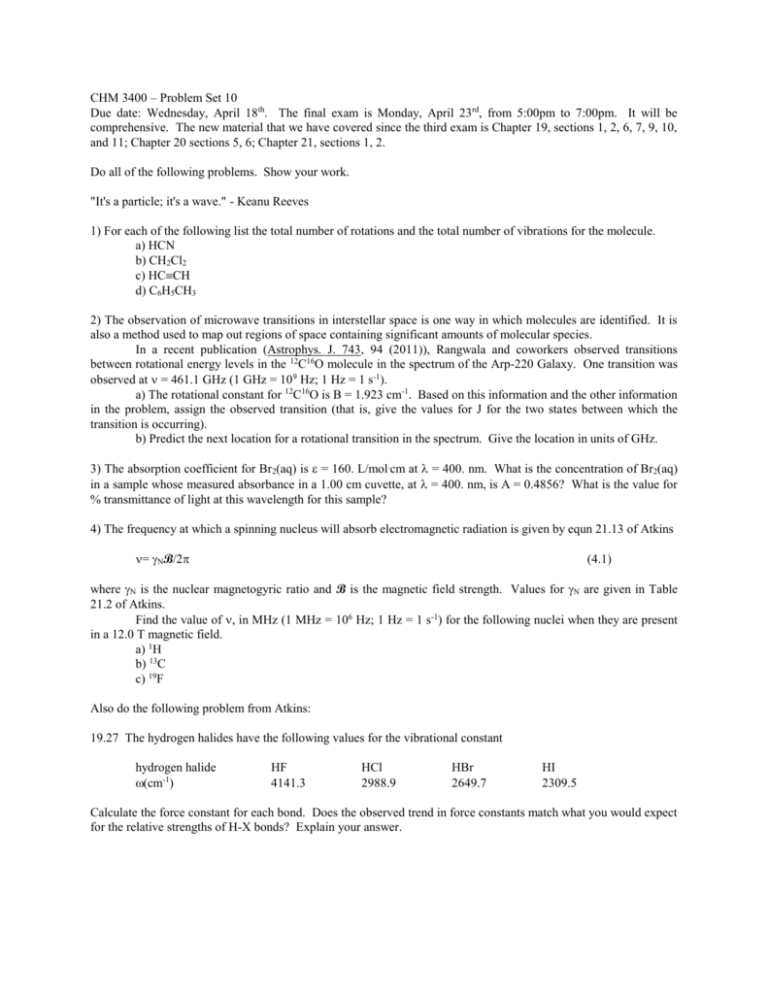
CHM 3400 – Problem Set 10 Due date: Wednesday, April 18th. The final exam is Monday, April 23rd, from 5:00pm to 7:00pm. It will be comprehensive. The new material that we have covered since the third exam is Chapter 19, sections 1, 2, 6, 7, 9, 10, and 11; Chapter 20 sections 5, 6; Chapter 21, sections 1, 2. Do all of the following problems. Show your work. "It's a particle; it's a wave." - Keanu Reeves 1) For each of the following list the total number of rotations and the total number of vibrations for the molecule. a) HCN b) CH2Cl2 c) HCCH d) C6H5CH3 2) The observation of microwave transitions in interstellar space is one way in which molecules are identified. It is also a method used to map out regions of space containing significant amounts of molecular species. In a recent publication (Astrophys. J. 743, 94 (2011)), Rangwala and coworkers observed transitions between rotational energy levels in the 12C16O molecule in the spectrum of the Arp-220 Galaxy. One transition was observed at = 461.1 GHz (1 GHz = 109 Hz; 1 Hz = 1 s-1). a) The rotational constant for 12C16O is B = 1.923 cm-1. Based on this information and the other information in the problem, assign the observed transition (that is, give the values for J for the two states between which the transition is occurring). b) Predict the next location for a rotational transition in the spectrum. Give the location in units of GHz. 3) The absorption coefficient for Br2(aq) is = 160. L/mol.cm at = 400. nm. What is the concentration of Br2(aq) in a sample whose measured absorbance in a 1.00 cm cuvette, at = 400. nm, is A = 0.4856? What is the value for % transmittance of light at this wavelength for this sample? 4) The frequency at which a spinning nucleus will absorb electromagnetic radiation is given by equn 21.13 of Atkins = NB/2 (4.1) where N is the nuclear magnetogyric ratio and B is the magnetic field strength. Values for N are given in Table 21.2 of Atkins. Find the value of , in MHz (1 MHz = 106 Hz; 1 Hz = 1 s-1) for the following nuclei when they are present in a 12.0 T magnetic field. a) 1H b) 13C c) 19F Also do the following problem from Atkins: 19.27 The hydrogen halides have the following values for the vibrational constant hydrogen halide (cm-1) HF 4141.3 HCl 2988.9 HBr 2649.7 HI 2309.5 Calculate the force constant for each bond. Does the observed trend in force constants match what you would expect for the relative strengths of H-X bonds? Explain your answer. Solutions. 1) The general rule for the number of fundamental rotations and vibrations of a molecule consisting of n atoms is as follows. Type of molecule So # rotations # vibrations linear 2 3n – 5 non-linear 3 3n – 6 a) HCN is linear, n = 3, and so 2 rotations, 4 vibrations. b) CH2Cl2 is non-linear, n = 5, and so 3 rotations, 9 vibrations c) HCCH is linear, n = 4, and so 2 rotations, 7 vibrations d) C6H5CH3 is non-linear, n = 15, and so 3 rotations, 39 vibrations 2) As discussed in class and on page 454 of Atkins, the rotational energy levels for a diatomic molecule are given by the expression E = J(J+1)B (where E, B are in units of cm-1) Because the selection rule for an allowed rotational transition is that the diatomic molecule be heteronuclear and that J = 1, the photon energies required for allowed transitions are E = 2(J+1)B (where E, B are in units of cm-1) where J is the quantum number of the lower energy rotational state (Fig 19.12, Atkins). a) The molecule absorbs at at frequency = 461.1 GHz = 461.1 x 109 s-1. Since c = E = (1/) = (/c) = (461.1 x 109 s-1)/(2.998 x 1010cm/s) = 15.380 cm-1 E = 2(J+1)B (J+1) = E/2B J = (E/2B) – 1 = [(15.380 cm-1)/2(1.923 cm-1)] – 1 = 2.999 3 The observed transition is therefore J = 3 4. b) The next higher energy transition will be J = 4 5, at an energy E = 2(J+1)B = 2(4+1)(1.923 cm-1) = 19.230 cm-1. = c/ = c(1/) = (2.998 x 1010cm/s)(19.230 cm-1) = 5.765 x 1011s-1 = 576.5 GHz 3) Beer’s law is A = c, and so c = A/() = 0.4856 = 3.04 x 10 -3 mol/L . (160. L/mol cm)(1.000 cm) A = - log10(%T/100%) 10-A = %T/100% %T = 10-A (100%) = 10-.4856 (100%) = 32.69 % 4) = NB/2 , so a) = (26.752 x 107 T-1s-1)(12.0 T) = 5.109 x 108 s-1 = 510.9 MHz 2 b) = (6.7272 x 107 T-1s-1)(12.0 T) = 1.285 x 108 s-1 = 128.5 MHz 2 c) = (25.177 x 107 T-1s-1)(12.0 T) = 4.808 x 108 s-1 = 480.8 MHz 2 19.27) As shown in problem 5 of problem set 9 k = 42c22 We need to find for each molecule, where (HX) = mHmX/(mH+mX). We will use the atomic masses from the periodic table (which will introduce a small error, as we should use the masses of the most abundent isotopes). If we give these masses in g/mol, then to get in units of kg (HX) = (10-3 kg/g) mHmX NA (mH+mX) molecule (kg) HF 1.589 x 10-27 HCl 1.627 x 10-27 HBr 1.653 x 10-27 HI 1.659 x 10-27 For HF k = 42c22 = 42(2.998 x 1010 cm/s)2(4143.3 cm-1)2(1.589 x 10-27 kg) = 968. N/m For HCl k = 42c22 = 42(2.998 x 1010 cm/s)2(2988.9 cm-1)2(1.627 x 10-27 kg) = 516 N/m For HBr k = 42c22 = 42(2.998 x 1010 cm/s)2(2649.7 cm-1)2(1.653 x 10-27 kg) = 412. N/m For HI k = 42c22 = 42(2.998 x 1010 cm/s)2(2309.5 cm-1)2(1.659 x 10-27 kg) = 314. N/m All of the H-X bonds are single bonds. As we go to larger and larger halogen atoms, the size of the halogen atom, and therefore the length of the covalent bond, increases. If the bond length increases we would expect the bond strength to decrease, as is observed above.


